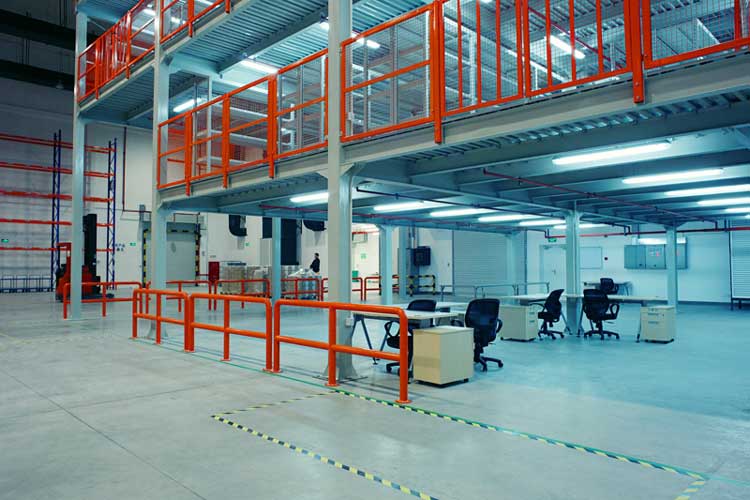Steel platform construction has become a preferred solution for modern industrial and commercial facilities that need to optimize vertical space, improve operational efficiency, and ensure long-term structural stability. The following explores the main advantages of steel platform construction, its applications, and why it is considered a practical choice for warehouses, factories, and storage centers.
What is Steel Platform Construction?
Steel platform construction refers to the process of building elevated structures using steel columns, beams, and decking. These platforms, often called mezzanine floors or steel structures, are commonly used to expand usable floor areas without extending the building footprint.
They can be installed inside existing buildings or as standalone systems. With their modular and load-bearing design, steel platforms are widely used for storage systems, production areas, office spaces, and maintenance zones.
Key Advantages of Steel Platform Construction
1. Efficient Use of Vertical Space
One of the main advantages of steel platform construction is its ability to maximize vertical space. In many industrial facilities, the floor area may be limited, but the ceiling height offers unused potential. By adding a steel platform, businesses can create additional working or storage levels without moving to a larger facility.
This makes steel platforms an efficient solution for warehouses, logistics centers, and manufacturing plants that need to increase capacity without high relocation or expansion costs.
2. High Load-Bearing Capacity and Strength
Steel is known for its exceptional strength-to-weight ratio, which gives steel platforms the ability to support heavy loads such as machinery, pallet racks, and inventory. The rigid structure ensures stability and safety, even under continuous industrial use.
Unlike wooden or concrete structures, steel platforms maintain their performance over time without warping, cracking, or deteriorating. This strength and reliability are key reasons why many facilities prefer steel platform construction for long-term operations.
3. Flexibility and Customization
Another advantage of steel platform construction is its high degree of design flexibility. Steel components can be easily customized based on space layout, load requirements, and functional needs. Whether the platform is single-tier, multi-tier, or integrated with storage systems, it can be adapted to fit various applications.
Additionally, steel platforms allow for easy integration with stairs, handrails, conveyors, and safety gates, enabling smooth workflow and compliance with safety standards.
4. Easy Installation and Short Construction Time
Steel platform construction is faster compared to traditional building methods. Most of the components are prefabricated at the factory and only require assembly on-site. This minimizes downtime and disruption to ongoing operations.
Because of the modular nature of steel platforms, they can also be relocated or modified as business needs change. This makes them a cost-effective and flexible investment for growing enterprises.
5. Durability and Low Maintenance
Steel platforms are built to withstand demanding environments such as factories, warehouses, and logistics centers. Their corrosion-resistant coatings, such as powder painting or galvanization, protect the structure against moisture and wear.
Maintenance is minimal—routine inspections and occasional cleaning are usually enough to keep the platform in good condition. The long lifespan and reduced maintenance costs make steel platform construction a sustainable choice for modern facilities.
6. Safety and Compliance
Safety is an essential consideration in any industrial setting. Steel platform construction adheres to strict engineering and safety standards, ensuring structural integrity and worker protection. Anti-slip decking, guardrails, and load-rated stairways are typically incorporated to prevent accidents.
The strong and stable structure also minimizes the risk of deformation or collapse, making steel platforms a safe option for personnel and equipment use.
Common Applications of Steel Platform Construction
Steel platform construction is widely used across various industries. Some common applications include:
Warehouse Storage Expansion – Adding an extra level for storing goods or pallets.
Manufacturing Facilities – Creating elevated work areas for assembly or equipment placement.
Office and Observation Platforms – Installing mezzanine levels for supervisors or administrative spaces.
Maintenance and Service Areas – Building platforms to access machinery or perform equipment maintenance.
These uses demonstrate how steel platform construction enhances both functionality and space efficiency in industrial and commercial operations.
Frequently Asked Questions (FAQ)
1. What materials are used in steel platform construction?
Steel platform construction primarily uses structural steel beams, columns, and decking. Accessories like handrails, staircases, and safety gates are also included to complete the design.
2. How long does it take to install a steel platform?
The installation time depends on the project size and complexity. However, since most steel parts are prefabricated, the assembly process is usually fast—often completed within a few days to a few weeks.
3. Can a steel platform be expanded or relocated?
Yes. One of the advantages of steel platform construction is its modularity. The structure can be expanded, adjusted, or even relocated with minimal structural modification.
4. Is a steel platform suitable for heavy machinery?
Absolutely. Steel platforms are designed to handle heavy loads, making them ideal for machinery, pallet racks, and industrial storage.
5. How do you maintain a steel platform?
Maintenance involves regular inspections for rust, loose bolts, and surface damage. Periodic repainting or recoating may be done to extend its service life.
Conclusion
Steel platform construction provides a practical and durable solution for expanding usable space in warehouses, factories, and industrial facilities. With its high strength, adaptability, safety, and fast installation, it has become a preferred choice for modern businesses aiming to enhance efficiency and maximize floor space.
If you are planning to upgrade your facility or need a customized platform design, contact Spieth Rack today for professional consultation and tailored steel platform solutions to fit your operational needs.
Post time: Oct-23-2025

